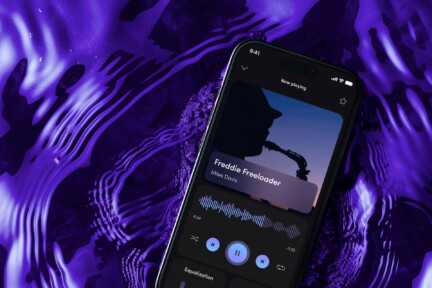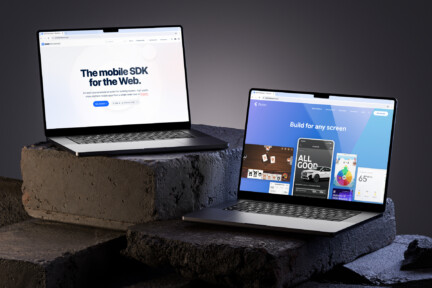A few years ago, live streaming was a curiosity, limited to niche circles like gaming enthusiasts and tech pioneers. Today, it’s a cornerstone of digital interaction, reshaping industries far beyond social media.
The rise of live streaming app features aligned with the explosion of online professions like content creation, fueling their growth and transforming how we connect, entertain, and do business. Musicians, influencers, and even everyday users have embraced live streaming to foster real-time engagement with their communities.
From occasional artist streams turning social media into modern meeting hubs to brands leveraging live streaming apps for marketing and direct sales, streaming apps have become indispensable. While some apps see it as a bonus feature, others have built their entire identity around it, spawning new professions and opportunities.
For providers of live streaming app development, the global market remains a promising frontier, offering vast opportunities for innovation in video streaming app development to meet the growing demand for quality and advanced features.
What does it take to deliver flawless live streaming apps? When does it make sense to integrate such functionality into your app? Read how streaming affected the music industry, entertainment, education, gaming, and business.
What is a live streaming feature?
In a nutshell, live streaming is a feature that allows users to broadcast audio and video in real time over the internet to their audience. The standard path for audio-visual data in such a function is as follows:
- The video and audio are captured from a camera and microphone and encoded into a digital format.
- The digital data is transmitted to viewers via a streaming server.
- The server ensures efficient content delivery, even to large audiences, using protocols such as RTMP or WebRTC.
What does a live streaming feature consist of?
Live streaming features can take various forms depending on the app’s nature and its purpose. The interface is crucial and should include elements allowing users to start, manage, and end streams.
The heart of live streaming is interaction with users, so they should be able to add comments, likes, and live reactions. Most live streaming apps include chat features, enabling users to share their thoughts in real time and interact with the streamer. The viewer interface provides access not only to chat and reactions but also to subscription and donation options. Depending on the options chosen by the streamer, donation notifications can be accompanied by specific or viewer-selected messages and sounds.
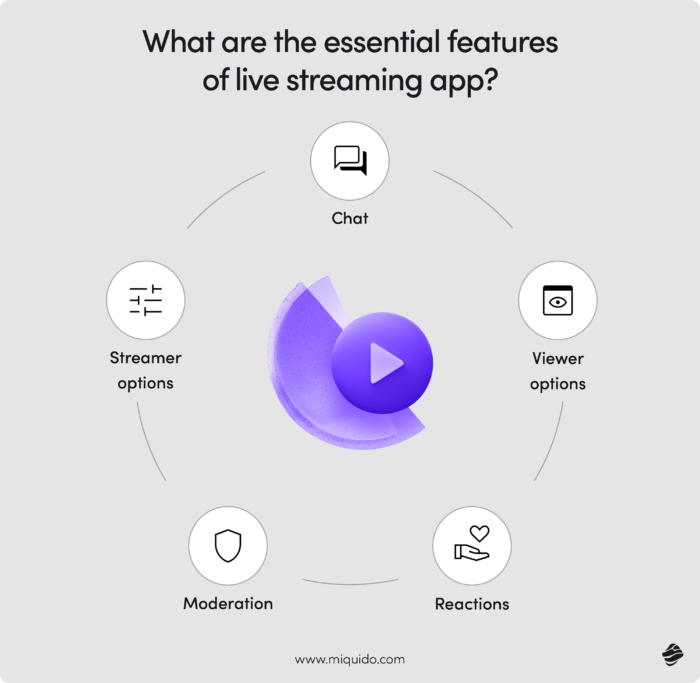
From the streamer’s perspective, the interface is slightly different. They can view their streamed content and chat, but they also have access to additional features in their UI. These include screen sharing, turning the camera and microphone on or off, and overlay management. Overlays refer to various graphic layers, such as logos or banners.
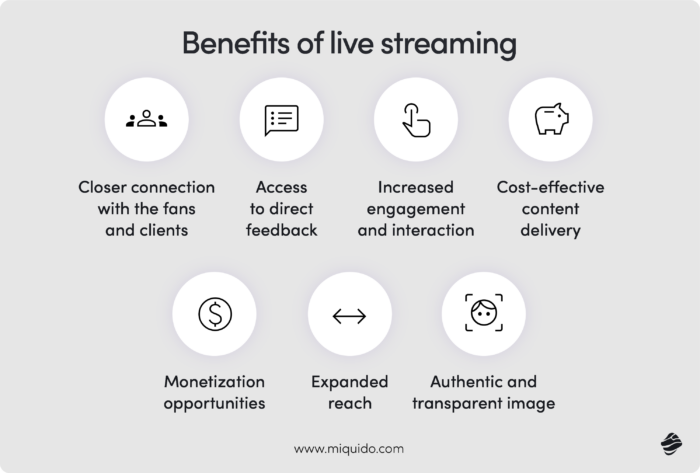
Technical infrastructure for live streaming app development
Live streaming is not an easy task—it requires not only thoughtful architecture and a well-designed user interface but also attention to multiple technical aspects. After all, this feature involves permissions for different devices, synchronization of visual and sound data in real time, and enabling interaction between the streamer and the audience. To ensure everything works smoothly, several key aspects must be addressed.
Servers for handling streams
Live streaming features can strain servers. Not every stream will attract a large audience, but it’s worth preparing for larger events. Choose high-performance servers capable of handling significant traffic, such as those in a content delivery network (CDN). Failing to account for this and selecting inappropriate servers can result in overloads, leading to disruptions.
Video transmission protocol
A video transmission protocol is critical for live video streaming, as it ensures efficient, reliable, and real-time delivery of video and audio data. Streaming protocols like RTMP, HLS, or WebRTC prepare the data for transmission, compress it for efficiency, and ensure synchronized playback even on unstable networks. Choosing the right protocol is essential for smooth operation.
Video encoding and decoding
The quality of a live video streaming app depends on proper video and audio codecs. The choice of codec directly impacts video quality, latency, and the user experience. To reduce buffering and ensure smooth streaming, even on slower networks, use codecs that allow for higher quality at lower bitrates, such as H.265. For interactive elements, focus on low-latency codecs while maintaining compatibility with mobile devices. H.264 remains the most universal option.
Camera and microphone integration
To ensure smooth integration of camera and microphone in live streaming apps, standardized APIs like WebRTC or MediaStream are key for compatibility across devices. The main challenge lies in handling diverse hardware and drivers, which can lead to issues like unsupported codecs, latency, or missing permissions. Address these challenges by providing clear permission prompts, offering fallback options for unsupported formats, optimizing codecs for low latency, and thoroughly testing across various devices.
Which apps have live streaming features?
Think back to the world five years ago. Live streaming? That was something only your nephew, a die-hard gaming fan, would talk about while spending hours watching matches on Twitch. Business meetings in virtual rooms? A harmless novelty mentioned in industry reports. School in the cloud? It sounded like a science fiction plot.
Then the pandemic hit, turning that world upside down. Overnight, streaming apps transformed from niche to necessity. Concerts, classes, fitness sessions, and even shopping moved online. Today, the live streaming app market is a thriving ecosystem catering to everyone—from gaming enthusiasts to businesses hosting global conferences. Whether you’re considering video streaming app development or simply looking to build a live streaming app for your audience, the demand is only growing. Let’s explore the key types of apps leveraging this feature.
Social media platforms
Do you remember when Instagram was primarily for posting photos, and Stories weren’t yet a part of your weekly routine? It wasn’t that long ago! Now, it’s hard to imagine social media without live video streaming apps. These features have become essential for fostering community. They allow artists, craftspeople, and creators to deepen connections with their audiences and even generate additional revenue streams.
However, live streams on social media aren’t all rainbows—there have been controversial and even tragic incidents on air. Fortunately, tools and safeguards are in place to reduce such risks.
Many platforms have embraced streaming app development, adding advanced features like tipping systems and real-time chat. With tools like Streamlabs or Periscope (on X, formerly Twitter), creators can elevate their live streaming platforms to new heights.
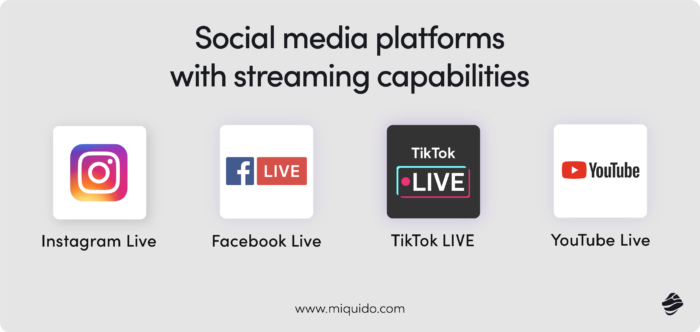
Gaming and e-sports platforms
The global live streaming market owes much of its success to gaming and esports platforms. These were among the first to demonstrate the potential of streaming apps. Interestingly, platforms like Twitch have evolved beyond gaming. Today, they’re used by political commentators and cultural analysts, connecting with audiences through live streams.
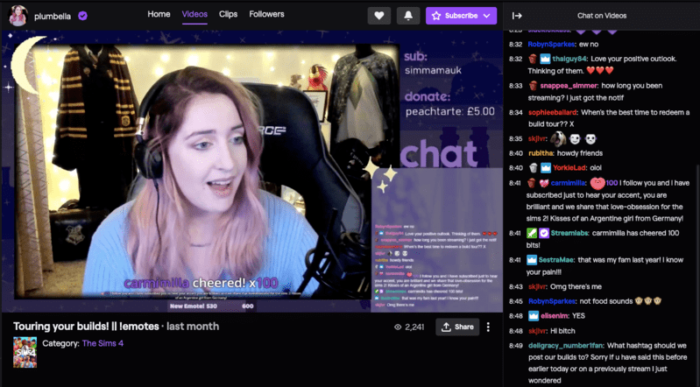
Image source
For generations raised online, this form of entertainment—immersive and participatory—feels like a natural way to engage with creators. Over time, many gaming-focused platforms have become multipurpose streaming platforms, widely used for communication and events. Whether it’s through mobile apps or desktop tools, live streaming apps has cemented its place as a core feature in this industry.
The success of these platforms may also change the future of music streaming. The music app giants may start incorporating live streaming features into their applications, enabling for more direct, app-integrated exchange between artists and streamers.
E-Commerce platforms
The digital space creates certain limitations when it comes to selling products. While augmented reality and 3D modeling help bridge this gap to some extent, nothing compares to showcasing products live from every angle. Plus, a skilled salesperson can use a live stream to highlight hidden selling points and create a sense of urgency. E-commerce platforms like Amazon Live and ShopShops enable sellers and influencers to showcase products through engaging, real-time presentations, merging entertainment with shopping.

Image source
Education and Webinars
Pandemic has changed the landscape of education forever. We saw both the brightest and darkest sides of learning online – the schools shut their doors, and the classroom moved to the cloud. Suddenly, live streaming apps were not just a backup plan; it became the lifeline of education. What began as a scramble to adapt has now evolved into a fully integrated part of how we learn.
Platforms like Kahoot! have turned quizzes into interactive livestreamed sessions, sparking engagement and collaboration. On Coursera, live interactive sessions add a personal touch to otherwise pre-recorded courses, while tools like Edmodo foster real-time teaching and interaction between educators and students. Digital education tools have evolved from forced alternative to the integral element of the learning flow.

Image source
Challenges of implementing live streaming apps and features
Safety
Stream hijacking is more common than we think, either aiming simply to disrupt but also for financial benefits. Take a “zoom bombing”, an epidemics of live stream hijacks that occured during the shift to online education due to COVID-19. Hackers disrupted live Zoom streams with offensive images, profanity, or even racial slurs.
Hackers also frequently take over YouTube channels to stream fake cryptocurrency giveaway promotions. In one high-profile case, they hijacked major accounts like Elon Musk’s and Apple’s official channels to run fraudulent live streams. These scams misled thousands of viewers into sending cryptocurrency under the guise of fake promises.
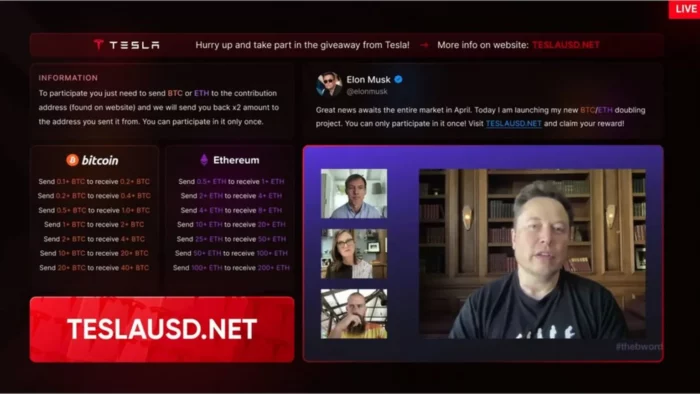
Image source
Streaming platforms also fall a victim of data breaches. Take Twitch that has experienced a massive one back in 2021. Although this wasn’t an on-air hijack, the breach led to widespread mistrust among streamers and users, highlighting vulnerabilities in platform security. Many streamers had to address their audiences about their leaked earnings, which sparked debates about fair monetization.
How to keep your users and streamers safe? Here are some good practices to follow in your entertainment software development process:
Guarantee safe encryption
Encrypting data transmitted during live streams is crucial for ensuring that unauthorized parties cannot intercept or alter the content. Protocols such as TLS (Transport Layer Security) or SRTP (Secure Real-Time Transport Protocol) can provide strong protection for audio and video streams, safeguarding both broadcasters and viewers.
Choose the safe authentication and access controls
Implement robust user authentication measures, such as requiring logins with two-factor authentication (2FA). For platforms with premium features, restrict access to live streams only to authorized users, like paid subscribers, to prevent unauthorized entry. These measures significantly reduce the risk of hijacks like “Zoom bombings.”
Adopt content protection via DRM
Employ Digital Rights Management (DRM) systems to prevent unauthorized copying or redistribution of streamed content. DRM solutions ensure that streams are viewable only through authorized devices and applications, protecting both intellectual property and the integrity of the content.
System load
Live streaming apps must account for system load during the design phase—failing to do so is playing with fire. Users have patience… but only to a point. A single failed stream can be the final straw that breaks the camel’s back, jeopardizing the platform’s entire reputation.
Netflix learned this lesson the hard way with its live reunion for the reality show Love is Blind. The event, hosted by the streaming giant, was riddled with technical failures and significant delays. The target audience, expecting smooth and seamless live streaming services, voiced their frustration on social media, leading to a wave of negative PR for Netflix. This incident served as a stark reminder of the importance of a robust backend infrastructure to handle high-traffic events effectively.
Leverage cloud infrastructure
- Use cloud services such as AWS, Google Cloud, or Azure, which enable automatic scaling of resources based on traffic. This ensures additional servers are brought online as viewer numbers increase and decommissioned as traffic subsides.
- Distribute traffic across multiple servers using tools like AWS Elastic Load Balancer, NGINX, or dedicated load-balancing systems in cloud environments. This prevents any single server from becoming a bottleneck.
Implement a content delivery network (CDN)
- Use CDNs such as Cloudflare, Akamai, or Fastly to distribute content globally, placing servers closer to users. This reduces latency and alleviates pressure on the main server.
- Optimize performance with cached video fragments, particularly for frequently replayed sections. CDNs equipped with dynamic buffering capabilities further enhance this proces
Regulatory compliance
Live streaming requires particular caution in the context of GDPR regulations. Such transmissions involve processing various types of data, not only audiovisual but also identification data (e.g., logins, emails, social media profiles) and technical data (e.g., IP addresses, geolocations, and device information). All these data categories fall under GDPR regulations, making it essential to obtain explicit consent for their processing.
To ensure GDPR compliance, consider implementing the following best practices:
Obtaining User Consent
- Inform participants about recording and data processing.
- Obtain explicit consent before starting the stream, especially when it involves personal images or voices.
- For children, secure consent from their legal guardians.
Privacy Policy
- Develop and share a clear privacy policy detailing what data is collected, the purpose of its collection, and the duration of its retention.
Data Encryption
- Secure streams using encryption protocols (e.g., TLS for data transmitted over the network) and ensure safe storage of recordings.
Access restriction
- Implement authorization mechanisms (e.g., login or subscriber-only streams).
- Limit access to recordings and data strictly to authorized personnel.
Anonymization and pseudonymization
- Where possible, anonymize technical or personal data to minimize the risk of user identification.
Risk Assessment and DPIA (Data Protection Impact Assessment)
- Conduct privacy impact assessments, particularly when introducing new features or innovative data uses.
Data management post-streaming
- Delete recordings or technical data after a set period if their continued storage is unnecessary.
- Enable users to request the removal of their data (the “right to be forgotten”).
What do I need to create a live streaming app?
An experienced team with experience in handling security and compliance issues is a must. As a music app development services provider with a few entertainment apps in our portfolio, we have implemented live features and understood their intricacies in practice. lLet’s discuss your idea or boost your existing features together!
And if you want to delve into streaming in the audio sphere a little more, our streaming music app development guide might be exactly what you are looking for.






